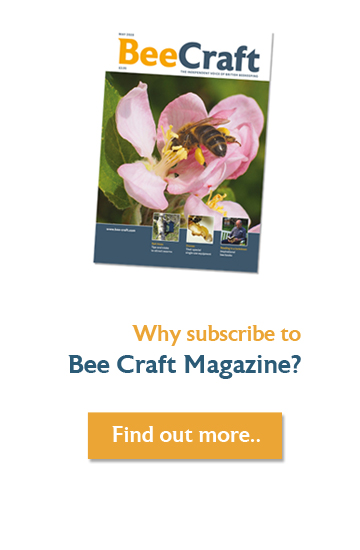Margaret Murdin, NDB, BBKA Chair of Trustees
 With the advent of February, those of us who have kept bees for a number of years start to wonder what the coming season will be like. We look forward to spring and good weather. But I hope that you, unlike me, have all your plans in place and your equipment well prepared.
With the advent of February, those of us who have kept bees for a number of years start to wonder what the coming season will be like. We look forward to spring and good weather. But I hope that you, unlike me, have all your plans in place and your equipment well prepared.
February and March are usually the danger times for colonies because, once the queen is in full lay, there are many young larvae to feed and a decreasing number of nurse bees to feed them.
The Importance of Pollen
These house bees are the old winter bees that are dying off and if they did not have a good supply of pollen to build up their fat bodies in the early autumn, they are unlikely to be good nurses.
To add to their difficulties, the weather is usually mixed in February. So, there might be some warm, dry, sunny days when the bees venture out for forage but there are likely to be as many cold, wet days when they can’t. And, at this time of year more than any, they need a good supply of pollen.
If it is good flying weather and you have a supply of nearby pollen then all may be well. Snowdrops, mahonia, early crocus or cherries are useful plants to have close to the apiary. This pollen is increasingly necessary because it is an essential ingredient of brood food, which the nurse bees produce and feed to the developing larvae.
If there is no nearby pollen, or if the weather is poor, now is the time to feed pollen supplement (a food containing real pollen) or pollen substitute (a food which has been formulated to replace the nutrients found in real pollen). The many varieties of pollen feed available from suppliers usually come in 1 kg packs which can be placed straight on the top bars. Just make a slit in the bottom of the plastic with your hive tool.
You can, of course, easily make your own.
Pollen Recipes
A pollen supplement can be made to the following recipe:
- 60% fat-free soya flour
- 20% brewer’s yeast
- 20% pollen (dried, from your own hives).
A pollen substitute can be made to the following recipe:
- 75% fat-free soya flour
- 25% brewer’s yeast.
Soya flour and brewer’s yeast can be purchased in wholefood stores or online.
Just place all the ingredients in a bowl, mix well and add sugar syrup to make a firm dough. Roll this into patties to place straight onto the top bars over the cluster. Cover the patties with cling film to stop them drying out.
Danger of Starvation
 Honey stores are also used up rapidly in February. These provide the energy for the bees to increase the temperature of the brood nest from 20 °C (which is the temperature at the centre of the cluster when there is no brood) to 34.5 °C, which is the temperature required for brood rearing. The stores are also used as an ingredient in brood food.
Honey stores are also used up rapidly in February. These provide the energy for the bees to increase the temperature of the brood nest from 20 °C (which is the temperature at the centre of the cluster when there is no brood) to 34.5 °C, which is the temperature required for brood rearing. The stores are also used as an ingredient in brood food.
So, in February and March, there is a danger of starvation and large colonies with a young, fecund queen are particularly vulnerable. This is why many of the colony deaths over winter occur in the early spring.
It is essential to check that the colonies have sufficient stores of honey or syrup. To check, heft the hive. Hold one side of the hive and lift two legs just off the ground. If it feels very light the colony probably needs feeding with fondant.
If you can’t heft the hive, just lift the crownboard very quickly and have a look. If the bees are clustered up at the top, then they are probably short of food and need feeding.
How to Feed
 It is still too cold for the bees to come up from their cluster to take liquid feed, so a pancake of fondant can be placed directly on the top bars and it can easily be combined with the pollen feed. Alternatively, a bag of granulated sugar can be given. Dip the unopened bag in warm water then make a few small cuts in the paper with a hive tool. The bag is then ready to be placed on the top bars or over the feed hole in the crownboard and surrounded by a super. Make sure the roof is replaced properly so that drafts are kept to a minimum.
It is still too cold for the bees to come up from their cluster to take liquid feed, so a pancake of fondant can be placed directly on the top bars and it can easily be combined with the pollen feed. Alternatively, a bag of granulated sugar can be given. Dip the unopened bag in warm water then make a few small cuts in the paper with a hive tool. The bag is then ready to be placed on the top bars or over the feed hole in the crownboard and surrounded by a super. Make sure the roof is replaced properly so that drafts are kept to a minimum.
Whatever you do, don’t open the hive to look inside. The bees work hard to maintain their brood nest temperature and they can chill easily and will use up the stores much more quickly in bringing the temperature back up again. Wait until you can work in shirt sleeves before opening the hive and doing a quick inspection.
Plans and Aspirations
So, what do we hope for in 2018?
Many of you will be hoping to increase the number of your colonies, or for a good honey crop, whereas I just want my queens to get well mated.
The beekeeping grapevine reports that it is more difficult these days for queens to get mated – but this is not the case in all areas, nor in all years
For many years now, there has been an increasing tendency for some beekeepers to import queens, mainly from other EU countries. Of course, well-mated queens can be obtained much earlier in the year from southern Europe and about 15,000 were imported in 2017 alone.
 But we have to ask whether these queens are always well suited to local conditions in the UK. And there is also the concern that diseases or pests could enter the country with them. I know that DEFRA is concerned about the high level of imports and is working with several beekeeping organisations to encourage beekeepers to source their queens locally. As a first step, I think they hope to find out exactly what beekeepers are doing currently and what they hope to achieve.
But we have to ask whether these queens are always well suited to local conditions in the UK. And there is also the concern that diseases or pests could enter the country with them. I know that DEFRA is concerned about the high level of imports and is working with several beekeeping organisations to encourage beekeepers to source their queens locally. As a first step, I think they hope to find out exactly what beekeepers are doing currently and what they hope to achieve.
So, the thing that I look forward to most is some successful queen rearing. Some beekeepers tell me that they buy queens because queen rearing is too difficult. Rearing your own queens is not difficult but it does take some planning. The real problem is that you have to stick to your plan regardless of external factors, like the weather. To have a beautiful, mated queen that I have reared myself is, for me, one of the most satisfying parts of beekeeping.
There are queen rearing courses on offer around the country and many experienced beekeepers who may help. So, if not already doing so, why not make 2018 the year that you start to raise your own queens?







